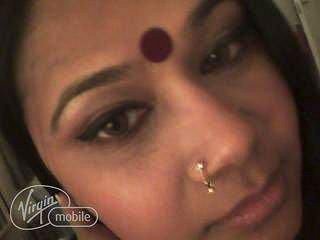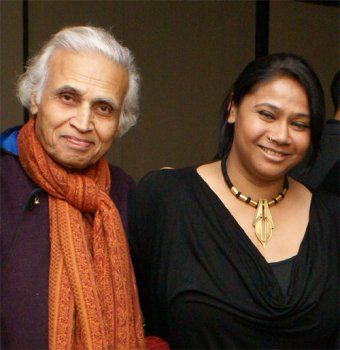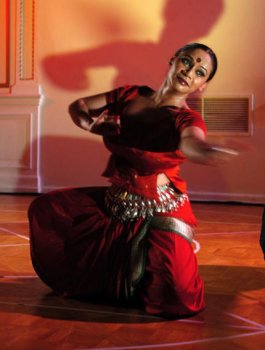
|
 |

|
 |
Myna Mukherjee - Director of Engendered Dance Festival - Sunil Kothari e-mail: sunilkothari1933@gmail.com June 11, 2010  The interview took place, in New Delhi and NewYork, with intermittent gaps and intervals over a period of two years, when Myna visited New Delhi and I visited New York. She had started Nayika group of feminist women dancers performing Odissi. It was dancer Sridhar Shanmugam of Chandralekha's group, who took me to see her group presentations in New York, three years ago. Asha Puthli, jazz singer and performer, a common friend Jaswant Lalwani and I attended her Odissi choreographic works. I was impressed with the innovations and treatment of her choreography of Chitra, the use of video and the contemporary approach. Myna has studied Odissi under several teachers including Mayadhar Raut, Divakar Khuntia, Ramani Ranjan Jena, Durga Charan Ranbir and performed extensively in India and in USA. Armed with MBA from Carnegie Melon University and exceptional management experience as a financial management consultant on Wall Street, she was doing well but gave up that lucrative career and opted for running Nayika dance group and moved on to an annual New York based transnational arts and human rights festival that brings together, as she puts it, "the best in contemporary South Asian cinema, visual arts and performance to explore complex realities at the intersection of ritual and religion." Excerpts from the interview: What propelled you to curate Engendered festivals? My home and world was dance. I had left many worlds, including one on Wall Street as a management consultant, to found Nayikas, New York's first feminist classical Indian Odissi dance theatre company. Dance was an immense educator for me. It taught me about my body - both personalizing and politicizing it. What do you mean by politicizing? It taught me about keeping an open mind, about relearning, about complicating and re-appropriating terms like 'feminine' and 'feminist.' But most of all, it taught me that the generation of new knowledge is and must be part of our relationship to our own art forms.  When was Engendered conceived as an arts festival? Three years ago at the Lincoln Centre in New York. I wanted to contextualize the work that Nayika did by bringing together other art practioners, theorists, and activists who would in turn, create a platform of mutual support and opportunities, active social and political networks, and be publicly recognized. It was also a space that would not shy away, rather embrace the challengingly complex and often dizzying cultural references of South Asia. Since then, Engendered has grown in ways that we could have barely imagined. What is different this time? After these past two years of packed programming, there is a great sense of homecoming and returning back to roots with this dance festival. This time around, the festival is vibrant with a very wide spectrum of voices, many expected and many that will be surprising. The genres of dances represented include not just classical and contemporary but also folk, Bollywood, and even nautch. Some of these have rarely been seen on the same stage together but together, they create a rich tapestry of dialogue with many points of entry and different points of view. How do you view arts and activism? The arts have been historically spaces of great activism in South Asia. They are powerful and transformative spaces: oral traditions of folk theatre have kept indigenous historical perspectives alive and helped fuel revolutions against colonization. Sufi and Bhakti folk music have helped create secular identities and bridge years of religious divides and fractures. Classical dance forms, as you know, have preserved alternative masculinities and femininities from pre-colonial eras as opposed to the two dimensional patriarchal formulations of gender, and so on and so forth. But Myna, how do you propose to deal with the issues of gender and sexuality as you know there are so many silences around gender and sexuality within South Asian culture? Leave alone that Sunil bhai, what about the two spaces of ritual and religion, which shape almost all our lives and cultures? This boundary is where Engendered starts. I believe that cultural change is one of the most important ways to advance activism and the rights movement and that religion needs to be part of that conversation. Every part of South Asian culture intersects with religion at some level. Religion is all pervasive and manifests itself in South Asia's art, architecture, social norms, even pop culture. Religion and ritual permeate both the everyday of our lives, but are implicitly and explicitly present in our politics. Have we not seen the use of religion by both ends of the political spectrum when it comes to gender and sexuality? For example, the idea of the 'Devi-Goddess' within Hinduism is just one example, appropriated by both conservative and liberal forces to their own normative trends - it reduced and silenced within both discourses by being made static and a-contextual.  I see that in your selection of classical dances, you have suggested that these dancers challenge these same static tropes and clichés. For example, Surupa and Bijayani of Nrityagram in their interpretation of Ardhanarishwara, penned by Shankaracharya, a number as 'Vibhakta' have demonstrated this challenge. Yes, I can see that as an Odissi dancer. Let me give you another example. Does not Sita, an icon of feminine virtues and strength, or victim to others, constantly enter into the every day discussions of gender and sexuality? Art can never be separated from its contemporary moment. Chandralekha used to argue that we must constantly re-appropriate and question the context and language as well as the static tropes dealt with in dance. You will see in this festival, we have raised the issue of Muslim voices and identities in such times of Islamaphobia. We have invited artists from Pakistan and Afghanistan to shape their own representations. Thus, this festival remains both political and aesthetic. It recognizes that aesthetics - virtual, ritual, cinematic, performative - are what define and shape our everyday lives. They teach us how to see, to perceive, to understand and how to judge. They are deeply political and yet intensely personal lenses through which to understand ourselves and the world around us. What are the fundamental questions you have been raising? What do the aesthetics of gender and sexuality tell us about South Asia? How could new narratives and new perspectives in these aesthetics raise new questions and discussions? How do our aesthetics of gender, sex, sexuality and the body, add to or limit our ability to speak of them politically and personally? Through text, words, visual art and performances. Engendered constantly returns to these fundamental questions. In their asking lies the political and aesthetic act that will take issues of gender and sexuality past their contemporary limits. The hope is to highlight not just what is being said on these issues, but also fights the silences that still abound within these conversations. Myna, please explain about Engendered, when you say that it was from the onset conceptualized as a transnational space. We live in a world where emotions across geographic boundaries are negotiated and exchanged via the internet - our world is both global and local. Hence the scale of Engendered requires a global exchange of ideas that is informed by local thinking and practices across South Asia and its Diapora. The choice of some of the modern pieces in the festival is based on exactly that consideration, specially the pieces from Britain. What do you hope to achieve through Engendered fests? I do hope that Engendered becomes a space where knowledge about local movements can be shared. Within South Asia, so many important and political artists are examining these complex issues in a very relevant and timely way, and pushing boundaries. How else would their expressions travel to the South Asian Diaspora? We want Engendered to be a space that would allow art to become a shared conversation between New York and New Delhi, London and Lahore, in a sense. For so many reasons, New York City is really the perfect place to present this dialogue. Art can be incredibly powerful in people's understanding of themselves. We hope that as our communities rethink themselves, this festival becomes a catalyst, a space of incubation and advocacy. It seems to be a stupendous task! Indeed, it is. But this curation is also largely personal and driven by my interest not just in art but also in the artists themselves. Artists, who understand, rewrite and knowingly or unknowingly change history, which think about themselves as narratives in the larger world of art - and have created new places for us to see and understand. I feel incredibly privileged, not just in the discovery of artists or new works but also in having the space to be able to communicate what I have discovered about myself, what I can offer in the space of a festival - to be able to talk about ourselves and to talk to each other. Thank you for accepting our invitation and attending the festival and taking part in the discussion panels. Myna Mukherjee can be contacted at: myna_m@yahoo.com Dr. Sunil Kothari, is a dance historian, scholar, author, and a renowned dance critic. |